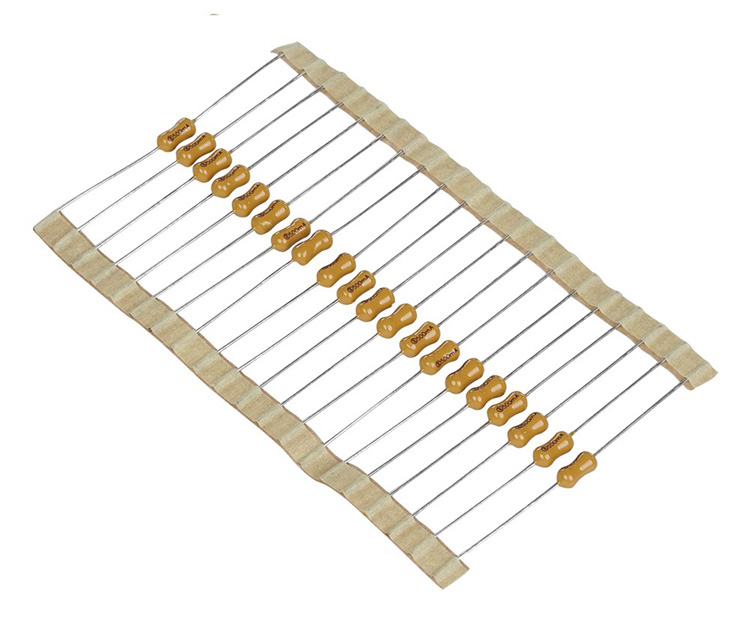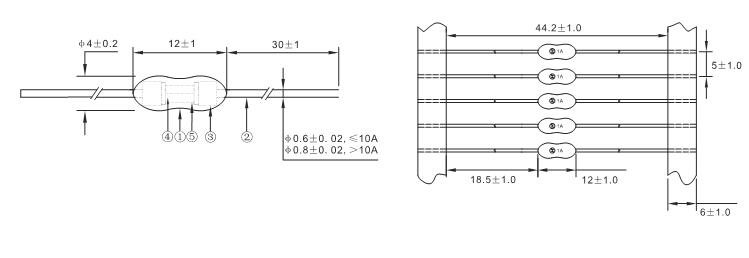4x11mm
Fast Acting High Reliability Subminiature Coaxial Pico Fuse F2A 350V
Description Of Coaxial Fast Acting Pico Fuse
What is a Pico Fuse,? A Pico fuse is an axial leaded
subminiature fuse, that is offered in both fast acting, and time lag, versions.
Fuse Pico voltage, ratings typically range from 32 volts to 350 volts AC with
the most common fuses rated at 125 volts AC. Radial leads are offered in some
Pico fuse series by bending the axial leads in the downward position. A Pico
fuse typically carries a UL Recognition, and CSA Approval,. MIL Spec, versions
of the Pico fuse are also available.



VARIATIONS IN DESIGN Of Coaxial Fast Acting Pico Fuse
Pico fuses which differ from the standard
versions as presented on this page can be provided for a commercial or military
use. One such design version is where the pico fuse terminates at one end of a
pin for use as a single or multi-pin connector. Extreme accuracy in blowing
time at 300% or more of rating, makes these pico fuses suitable for use in circuits
where sequential switching or redundancy may be required. The small size of the
fuse, its non-hygroscopic characteristic and infinitesimal weight makes it the
ideal fuse for micro-electronic circuits
Standards and Agency Approvals Of Coaxial Fast Acting Pico Fuse
Standards:In
accordance with UL 248 -1 / -14.
|
Voltage Rating
|
Agency
|
Ampere Range
|
Agency File
Number
|
|
350V
|
UL
|
100mA ~ 10A
|
E340427(JDYX2)
|
|
C-UL
|
100mA ~ 10A
|
E340427(JDYX8)
|
Dimension Of Coaxial Fast Acting Pico Fuse (mm)

Specifications Of Coaxial Fast Acting Pico Fuse
Test Condition: All electrical test is to be conducted with the ambient air at
a temperature of 25±5℃.
Load capacity:When the fuse loads through 100% of rated
current, should blow within 4 hours.
Interrupting Rating:Breaking Capacity: 50A at 350V AC.
|
% of Ampere Rating(In)
|
Blowing Time
|
|
100% * In
|
4 hours Min
|
|
200% * In
|
60 sec Max
|
|
Catalog
No.
|
Ampere
Rating
|
Voltage
Rating
|
Breaking
Capacity
|
Agency Approvals
|
|
|
|
|
|
RFP0100
|
100mA
|
350V
|
50A@350VAC
|
●
|
●
|
○
|
|
RFP0125
|
125mA
|
350V
|
50A@350VAC
|
●
|
●
|
○
|
|
RFP0160
|
160mA
|
350V
|
50A@350VAC
|
●
|
●
|
○
|
|
RFP0200
|
200mA
|
350V
|
50A@350VAC
|
●
|
●
|
○
|
|
RFP0250
|
250mA
|
350V
|
50A@350VAC
|
●
|
●
|
○
|
|
RFP0300
|
300mA
|
350V
|
50A@350VAC
|
●
|
●
|
○
|
|
RFP0315
|
315mA
|
350V
|
50A@350VAC
|
●
|
●
|
○
|
|
RFP0350
|
350mA
|
350V
|
50A@350VAC
|
●
|
●
|
○
|
|
RFP0375
|
375mA
|
350V
|
50A@350VAC
|
●
|
●
|
○
|
|
RFP0400
|
400mA
|
350V
|
50A@350VAC
|
●
|
●
|
○
|
|
RFP0500
|
500mA
|
350V
|
50A@350VAC
|
●
|
●
|
○
|
|
RFP0600
|
600mA
|
350V
|
50A@350VAC
|
●
|
●
|
○
|
|
RFP0630
|
630mA
|
350V
|
50A@350VAC
|
●
|
●
|
○
|
|
RFP0700
|
700mA
|
350V
|
50A@350VAC
|
●
|
●
|
○
|
|
RFP0750
|
750mA
|
350V
|
50A@350VAC
|
●
|
●
|
○
|
|
RFP0800
|
800mA
|
350V
|
50A@350VAC
|
●
|
●
|
○
|
|
RFP1100
|
1A
|
350V
|
50A@350VAC
|
●
|
●
|
○
|
|
RFP1125
|
1.25A
|
350V
|
50A@350VAC
|
●
|
●
|
○
|
|
RFP1150
|
1.5A
|
350V
|
50A@350VAC
|
●
|
●
|
○
|
|
RFP1160
|
1.6A
|
350V
|
50A@350VAC
|
●
|
●
|
○
|
|
RFP1200
|
2A
|
350V
|
50A@350VAC
|
●
|
●
|
○
|
|
RFP1250
|
2.5A
|
350V
|
50A@350VAC
|
●
|
●
|
○
|
|
RFP1300
|
3A
|
350V
|
50A@350VAC
|
●
|
●
|
○
|
|
RFP1315
|
3.15A
|
350V
|
50A@350VAC
|
●
|
●
|
○
|
|
RFP1350
|
3.5A
|
350V
|
50A@350VAC
|
●
|
●
|
○
|
|
RFP1400
|
4A
|
350V
|
50A@350VAC
|
●
|
●
|
○
|
|
RFP1500
|
5A
|
350V
|
50A@350VAC
|
●
|
●
|
○
|
|
RFP1600
|
6A
|
350V
|
50A@350VAC
|
●
|
●
|
○
|
|
RFP1630
|
6.3A
|
350V
|
50A@350VAC
|
●
|
●
|
○
|
|
RFP1700
|
7A
|
350V
|
50A@350VAC
|
●
|
●
|
○
|
|
RFP1800
|
8A
|
350V
|
50A@350VAC
|
●
|
●
|
○
|
|
RFP1900
|
9A
|
350V
|
50A@350VAC
|
●
|
●
|
○
|
|
RFP2100
|
10A
|
350V
|
50A@350VAC
|
●
|
●
|
○
|
|
RFP2120
|
12A
|
350V
|
50A@350VAC
|
○
|
○
|
○
|
|
RFP2150
|
15A
|
350V
|
50A@350VAC
|
○
|
○
|
○
|
Why does a fuse blow?
First off we need to understand what a fuse is. A fuse is a
safety device, primarily designed to protect something from fire or damage. A
normal fuse is simply a small wire running from one electrode to another
electrode and encapsulated in some kind of fire proof casing.
A fuse should not be confused with a circuit breaker. A circuit
breaker has the same purpose as a fuse, but it can be re-set and used again. A
fuse has to be replaced when it blows.
Fuses, especially ones found in a television, can be very
deceiving and hard to find. They come in many shapes and sizes. Other
components like; resistors, or coils, may also do double duty and act like a
fuse. This behavior is engineered into the component.
A fuse under normal conditions will allow the free flow of
electricity to the circuit it is feeding. Normally, if everything is working
correctly, the fuse has absolutely no effect on the circuit. If the circuit
that the fuse is feeding draws too much current, the fuse wire will get very
hot, very fast, causing the wire to disintegrate or burn open in one spot. Once that wire has been broken, no
electricity can pass through to the circuit beyond.
It is extremely rare that a fuse will blow without another
problem causing it to blow. After all, that is its purpose. It is designed to
blow if something else is wrong, especially in a TV or other appliance. If a
fuse is blown in a TV, expect that you will need to fix it.
Most of us are used to dealing with fuses, or breakers, in our
house. By replacing the fuse, we usually make it all better again. But when you
think about it, the fuse only blew because you had the bathroom heater turned
on at the same time you had the blow dryer turned on. So you overloaded the
circuit. Again, you had to fix something to keep the fuse from blowing, like
turning off the heater while you were blow-drying your hair. Replacing the fuse
did not fix the problem. Turning off the heater fixed the problem. The fuse was
a symptom of the problem. Inside the television you have no control over how
much power is being used. So the reason that fuse blew is inside the TV it’s
self.
Power surges from
lightning or power line transmission problems can cause a fuse to blow. The abnormal voltage and current flows in
this situation will usually do more damage to the TV, but in some rare cases
the fuse is all that has blown. If an internal fuse has blown, it always has to
do with a problem in the television.
When you replace the fuse, use the same amperage, because
increasing the amperage does not help, it just allows the circuit more current,
possibly causing a fire. If the circuit keeps blowing a fuse, you have a
problem that needs to be addressed and resolved. Don’t mask a problem by trying
a higher amperage fuse. This will only make your problem worse.
Hot Tags: Coaxial Fast Acting Pico Fuse, China, Manufacturers, Suppliers, Factory, Made in China, Wholesale, Buy, Customized, in stock, Bulk, Free Sample, Cheap, Discount, Buy discount, Low price, Price, Price list, Quotation
 English
English  Español
Español  Português
Português  русский
русский  Français
Français  日本語
日本語  Deutsch
Deutsch  tiếng Việt
tiếng Việt  Italiano
Italiano  Nederlands
Nederlands  ภาษาไทย
ภาษาไทย  Polski
Polski  한국어
한국어  Svenska
Svenska  magyar
magyar  Malay
Malay  বাংলা ভাষার
বাংলা ভাষার  Dansk
Dansk  Suomi
Suomi  हिन्दी
हिन्दी  Pilipino
Pilipino  Türkçe
Türkçe  Gaeilge
Gaeilge  العربية
العربية  Indonesia
Indonesia  Norsk
Norsk  تمل
تمل  český
český  ελληνικά
ελληνικά  український
український  Javanese
Javanese  فارسی
فارسی  தமிழ்
தமிழ்  తెలుగు
తెలుగు  नेपाली
नेपाली  Burmese
Burmese  български
български  ລາວ
ລາວ  Latine
Latine  Қазақша
Қазақша  Euskal
Euskal  Azərbaycan
Azərbaycan  Slovenský jazyk
Slovenský jazyk  Македонски
Македонски  Lietuvos
Lietuvos  Eesti Keel
Eesti Keel  Română
Română  Slovenski
Slovenski  मराठी
मराठी  Srpski језик
Srpski језик 
















